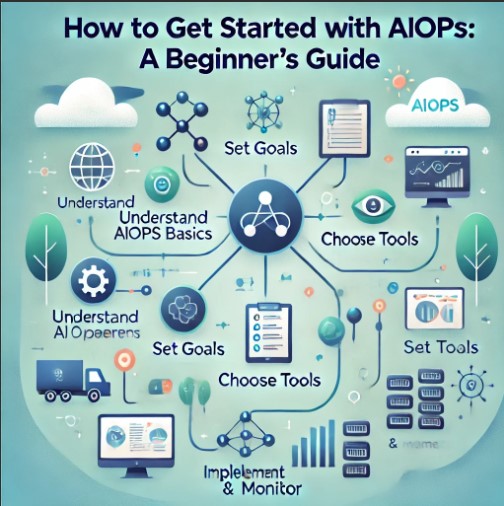Table of Contents
Introduction
In today’s fast-paced digital landscape, IT operations face increasing pressure to manage complex systems, ensure uptime, and deliver seamless user experiences. Enter AIOps (Artificial Intelligence for IT Operations), a transformative approach that leverages AI and machine learning to enhance IT operations’ efficiency and effectiveness.
This guide, “How to Get Started with AIOps: A Beginner’s Guide,” will walk you through the essential steps to embark on your AIOps journey.
Understanding AIOps
What is AIOps?
AIOps stands for Artificial Intelligence for IT Operations. It involves using AI and machine learning to automate and enhance various IT operations tasks, such as monitoring, analytics, and incident management. AIOps aims to improve the speed and accuracy of IT operations, leading to better system performance and reduced downtime.
Why is AIOps Important?
AIOps is essential for modern IT operations because it:
- Reduces Manual Effort: Automates routine tasks, freeing up IT staff for more strategic activities.
- Enhances Problem-Solving: Uses predictive analytics to identify and resolve issues before they impact users.
- Improves Efficiency: Streamlines processes, resulting in faster incident resolution and optimized resource utilization.
- Supports Scalability: Easily scales to manage the growing complexity of IT environments.
Getting Started with AIOps
Step 1: Assess Your Current IT Environment
Before diving into AIOps, it’s crucial to understand your existing IT infrastructure. Conduct a thorough assessment to identify:
- Current Tools and Systems: List all monitoring, logging, and incident management tools in use.
- Pain Points: Highlight areas where manual processes are time-consuming or error-prone.
- Data Sources: Identify where your data is coming from, such as servers, applications, and network devices.
Step 2: Define Your AIOps Goals
Set clear objectives for your AIOps implementation. Consider goals such as:
- Improving Incident Response Time: Aim to reduce the time it takes to detect and resolve incidents.
- Enhancing System Performance: Focus on optimizing resource usage and reducing downtime.
- Automating Routine Tasks: Identify specific tasks that can be automated to improve efficiency.
Step 3: Choose the Right AIOps Tools
Selecting the appropriate AIOps tools is critical to your success. Look for tools that offer:
- Integration Capabilities: Ensure compatibility with your existing IT infrastructure and tools.
- Machine Learning Algorithms: Tools with robust AI capabilities for predictive analytics and anomaly detection.
- User-Friendly Interface: A dashboard that provides clear insights and actionable recommendations.
Step 4: Prepare Your Data
Data is the foundation of AIOps. To prepare your data:
- Centralize Data Sources: Consolidate data from various sources into a single repository.
- Ensure Data Quality: Clean and normalize your data to eliminate inconsistencies and inaccuracies.
- Label Data: Properly tag and categorize data to facilitate machine learning and analytics.
Step 5: Implement AIOps in Phases
Gradual implementation is key to a successful AIOps adoption. Follow these phases:
- Pilot Phase: Start with a small, manageable project to test the waters and gather insights.
- Expansion Phase: Gradually extend AIOps to other areas of your IT operations based on the pilot’s success.
- Optimization Phase: Continuously refine and optimize your AIOps processes for maximum efficiency.
Key Components of AIOps
Machine Learning and AI
AIOps relies heavily on machine learning and AI to analyze data, detect patterns, and make predictions. These technologies enable:
- Anomaly Detection: Identifying unusual patterns that could indicate potential issues.
- Predictive Analytics: Forecasting future incidents and performance trends based on historical data.
- Automated Decision-Making: Enabling systems to take corrective actions without human intervention.
Data Ingestion and Integration
Effective AIOps requires seamless data ingestion and integration. This involves:
- Real-Time Data Collection: Continuously gathering data from various sources in real-time.
- Data Aggregation: Combining data from different sources into a unified view.
- API Integration: Using APIs to integrate AIOps tools with existing IT systems.
Visualization and Dashboards
AIOps platforms provide visualization tools and dashboards that offer:
- Real-Time Insights: Up-to-the-minute views of system performance and health.
- Actionable Alerts: Immediate notifications of potential issues with recommended actions.
- Customizable Views: Tailored dashboards to meet the specific needs of different users.
Best Practices for AIOps Implementation
Foster Collaboration
Encourage collaboration between IT operations, data scientists, and other stakeholders to ensure a smooth AIOps implementation. This involves:
- Regular Communication: Hold frequent meetings to discuss progress, challenges, and opportunities.
- Shared Goals: Align everyone on common objectives and performance metrics.
- Cross-Functional Teams: Form teams with diverse skills to tackle complex problems effectively.
Focus on Continuous Improvement
AIOps is not a one-time project but an ongoing journey. Emphasize continuous improvement by:
- Monitoring Performance: Regularly track key performance indicators (KPIs) to assess AIOps effectiveness.
- Learning from Incidents: Analyze resolved incidents to identify lessons learned and areas for improvement.
- Updating Algorithms: Continuously refine machine learning models to improve accuracy and relevance.
Ensure Data Security and Privacy
Protecting data is paramount in AIOps. Implement robust security measures, such as:
- Data Encryption: Encrypt data at rest and in transit to prevent unauthorized access.
- Access Controls: Limit access to sensitive data based on user roles and responsibilities.
- Compliance: Adhere to regulatory requirements and industry standards for data protection.
FAQs on How to Get Started with AIOps: A Beginner’s Guide
What is the first step to get started with AIOps?
The first step is to assess your current IT environment to understand the existing tools, pain points, and data sources.
How do I choose the right AIOps tools?
Select tools that offer integration capabilities, robust machine learning algorithms, and a user-friendly interface.
Why is data preparation important in AIOps?
Data preparation ensures that your data is accurate, consistent, and properly labeled, which is crucial for effective machine learning and analytics.
Can AIOps be implemented in phases?
Yes, a phased approach starting with a pilot project is recommended for a successful AIOps implementation.
How does AIOps improve incident response time?
AIOps uses predictive analytics and automated decision-making to quickly detect and resolve incidents, reducing response time.

Conclusion
Embarking on the journey of AIOps can transform your IT operations, making them more efficient, proactive, and resilient. By following this comprehensive guide, “How to Get Started with AIOps: A Beginner’s Guide,” you can lay a solid foundation for your AIOps implementation. Remember, the key to success lies in careful planning, continuous improvement, and fostering collaboration across your organization. Embrace the power of AIOps and elevate your IT operations to new heights. Thank you for reading the DevopsRoles page!
